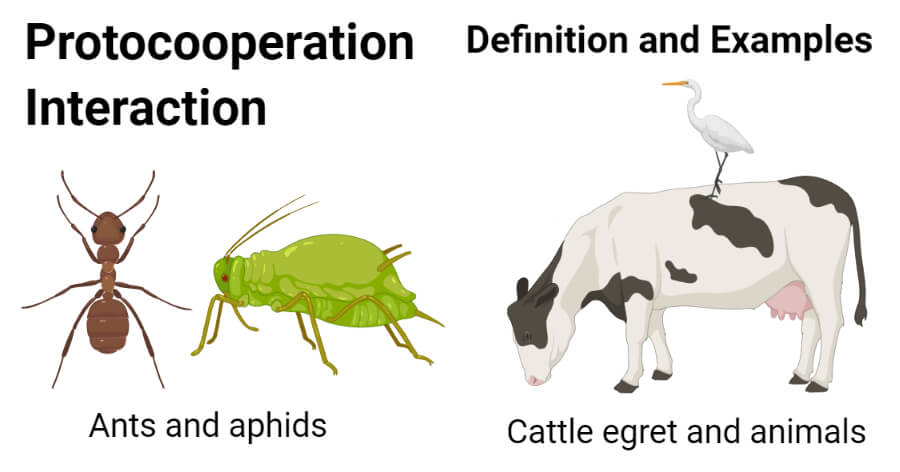Interesting Science Videos
Protocooperation Definition
Protocooperation is a type of ecological interaction where both the species involved in the interaction are benefitted, but the interaction is not obligatory for survival.
- The interaction between species in protocooperation is simply for the gain they receive from the interaction. The interaction is often considered a type of mutualism (facultative mutualism).
- Even though the interaction increases the chances of survival and supports growth, it is not necessary for the general growth and survival of the species.
- Protocooperation is a type of mutualism as the interaction benefits all the species involved.
- The term protocooperation was initially used to indicate intraspecific interactions but was later popularized by Eugene Odum in 1953. Protocooperation is also termed as ‘synergism’ in some cases.
- Protocooperation is a type of positive interaction where the relationship can be service-service, service-resource, or resource-resource. The interaction is mostly observed between two distinct species or even species from different kingdoms.

Examples of Protocooperation
1. Ants and aphids
- The interaction between ants and aphids is an example of protocooperation. This is a type of service-resource relationship.
- The aphids occurring in different plant species provide honeydews to the ants which act as a source of food or nutrients. The aphids might release the dews either on the stems of the plant or directly into the mouth of the ants.
- The ants, in turn, carry the aphids into their homes at night to protect the aphids against predators. They then bring them back to the stems in the morning.
- In this case, the ants provide a service in the form of protection, whereas the aphids provide a resource in the form of food.
- The interaction is thus, beneficial for both, but it is not an obligatory relationship as both the species can exist on their own in the absence of the interaction.
- This tends to increase the occurrence of ants and aphids in different plants which might be harmful to the plant but is beneficial to the species involved in the interaction.
2. Cattle egret and animals
- The cattle egret is a type of bird that feeds on a wide range of insects ranging from maggots, moths, spiders, and even earthworms.
- These birds also capture prey present on the surface of cattle, and it has been found the birds are about 3.6 times more successful in capturing prey when present around cattle.
- The interaction helps the animals as it gets rid of any external parasites of insects that might be present on their bodies.
- The egrets often forage around species that move slower like zebras and wild buffaloes.
- Both of these animals can exist on their own, but the interaction benefits both of the species involved.
3. Schwarzule bees and Cryptostigma ants
- A protocooperation interaction also exists between Amazonian bees and scale ants. The bees exist in tree holes which are often previously occupied by moth caterpillars.
- These holes are also simultaneously housed by scale insects. The scale insects feed on the sap produced by the tree and excrete honeydew.
- The bees present in the same holes feed on the honeydew for their nourishment while protecting the ants from drowning in their own wastes.
- Thus, both species occupy the same niche while benefitting each other. The relationship is often termed as cleaning symbiosis as one of the species helps in the cleaning of the species by removing the waste materials.
- Both of the species can exist in the absence of the other, and thus, the interaction is not obligatory.
References and Sources
- Tshikantwa, Tiroyaone Shimane et al. “Current Trends and Potential Applications of Microbial Interactions for Human Welfare.” Frontiers in microbiology vol. 9 1156. 1 Jun. 2018, doi:10.3389/fmicb.2018.01156.
- 1% – https://www.thoughtco.com/how-do-species-interact-130924
- 1% – https://www.researchgate.net/publication/328285239_Endohyphal_bacteria_the_prokaryotic_modulators_of_host_fungal_biology
- 1% – https://www.researchgate.net/publication/286295140_Mutualism_Ants_and_their_Insect_Partners
- 1% – https://www.biology-questions-and-answers.com/symbiosis.html
- 1% – https://en.wikipedia.org/wiki/Protocooperation
- 1% – https://en.wikipedia.org/wiki/Cattle_Egret
- <1% – https://study.com/academy/flashcards/symbiotic-relationships-list-flashcards.html
